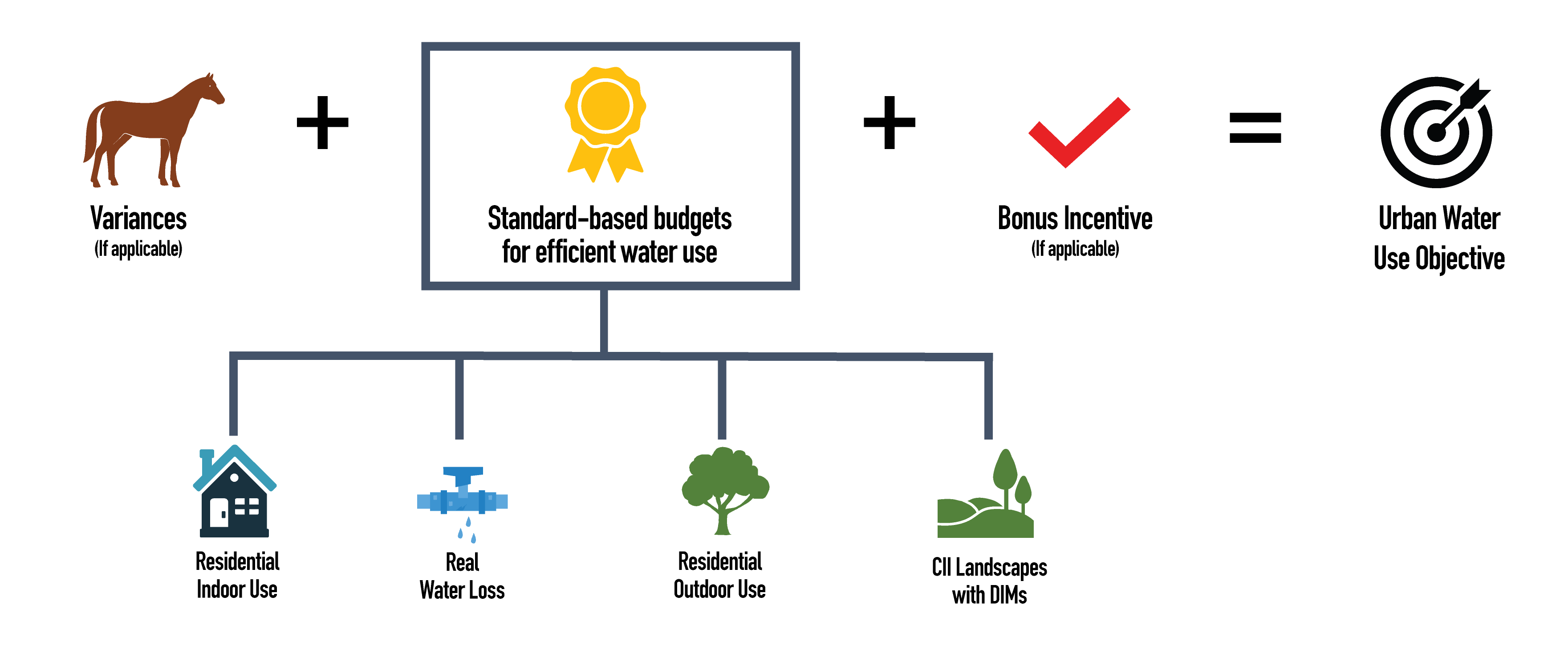Water Use Objective Exploration Tool
This tool is intended to help all parties interested in the implementation of AB 1668 and SB 606 explore how proposed efficiency standards may affect urban water use. When users adjust the various parameters, the tool shows possible future scenarios and compares those to recent water use trends and the 2020 efficiency targets established by past legislation (SB X7-7, 2009).
The tool is not intended as a reporting tool, nor does it define what the any of the efficiency standards will be. The calculated reductions are shown relative to 2017-2021 water use and population data; actual water use reductions that might be required may change based on factors such as population growth or land use changes. Furthermore, the possible future scenarios generated by the tool do not integrate all components of the proposed regulation (e.g., variances, caps based on SB X7-7 targets) and are limited to historic data.
The tool is a work in progress and will be updated as more data become available. Feedback or corrected data are welcome and encouraged. Please e-mail the State Water Board’s conservation team at ORPP-WaterConservation@Waterboards.ca.gov.
The Excel file below contains much of the data that is the basis for the Water Use Objective Exploration Tool; the data include 2017-2021 water use data for 396 urban retail water suppliers, as well as residential landscape area measurement and annual evapotranspiration and precipitation data provided by the Department of Water Resources. This file also contains examples of budget-based total water use volumes that would result under the various proposed standards for 2025, 2030, 2035 and 2040. Please note that the budget totals shown here are not the final budget values that suppliers would be subject to under the proposed regulation; they are examples of how calculations would be performed based on provided data.
The accompanying PDF file provides information on the underlying calculations that were performed to produce the budget-based total water use volumes, as well as data caveats and a data dictionary.
Provisional Data Released as Part of Making Conservation a California Way of Life Proposed Regulation (Version 4.1, 2024-06-04)
Documentation for Provisional Data Released as Part of Making Conservation a California Water of Life Proposed Regulation (Version 4.0, 2024-05-20)
Water Use Objective Exploration Tool
Using the Tool
Dashboard Tabs
Tool: Allows users to explore how adjusting different parameters could affect the resulting objective for any given urban retail water supplier.
Data Inputs: Summary of all data displayed in the "Tool" tab. The "Download Summary" button allows the user to print one or more of the tabs to PDF. Choose "Specific sheets from this workbook" to select more than one tab.
Glossary: Defines tool terms and provides data sources.
Help Tips
 Hover over the question mark icon to view simple explanations of each tool parameter.
Hover over the question mark icon to view simple explanations of each tool parameter.
The Water Conservation legislation of 2018 (SB 606 and AB 1668) established a new foundation for long-term improvements in urban water supplier conservation and drought planning in order to adapt to climate change and the longer more intense droughts in California.
The 2018 legislation applies to the actions of the Department of Water Resources (Department), the State Water Resources Control Board (State Water Board), and urban retail water suppliers (suppliers); under the proposed regulation, Suppliers will annually calculate urban water use objectives based on standards applied at the service-area scale. Individual households and business will not be subject to the proposed regulation.
In carrying out the legislation, the Department provided recommendations to the State Water Resource Control Board in Fall 2022. The State Water Board began the rulemaking process for the Making Conservation a Way of Life regulation on August 18, 2023.
The proposed regulation that will set the outdoor standards as well as establish how variances, the bonus incentive, and the urban water use objective will be calculated. The residential indoor standard is set by the legislature; the water loss standard will be set by the water loss regulation.
The infographic below shows generally how the urban water use objective would be calculated each year.

The following components of a supplier’s urban water use objective either rely on surrogate data or are excluded from the tool at this time:
- The budget associated with the standard for outdoor irrigation of landscape areas with Dedicated Irrigation Meters (DIM) in connection with Commercial, Institutional, and Industrial (CII) water use. Once the landscape area for CII landscapes with DIMs has been estimated, those data will be integrated into the tool. In the interim, the tool assumes this budget is equal to “landscape irrigation” deliveries, as reported by suppliers in the Electronic Annual Report.
- Budgets associated with variances. Variances are for unique uses that can have a material effect on an urban retail water supplier’s urban water use objective. Examples include significant fluctuations in seasonal population or significant use of evaporative coolers. Variances may be included in the tool as requisite data become available.
- The statutory requirement that the long-term budgets be set at a level designed so that the water use objectives, together with other demands excluded from the long-term standards (such as CII indoor water use), exceed the SBx7-7 targets (water code section 10609.2(d)).
Learn more about Making Conservation a California Way of Life:
- Factsheet describing the proposed legislation
- Making Water Conservation a California Way of Life – Primer of 2018 Legislation on Water Conservation and Drought Planning, Senate Bill 606 (Hertzberg) and Assembly Bill 1668 (Friedman), the Primer outlines the key authorities, requirements, timeline, roles, and responsibilities of State agencies, water suppliers, and other entities during implementation of actions described in the 2018 legislation.
- The Department of Water Resources’ website describing the 2018 water conservation legislation
- Save Our Water



